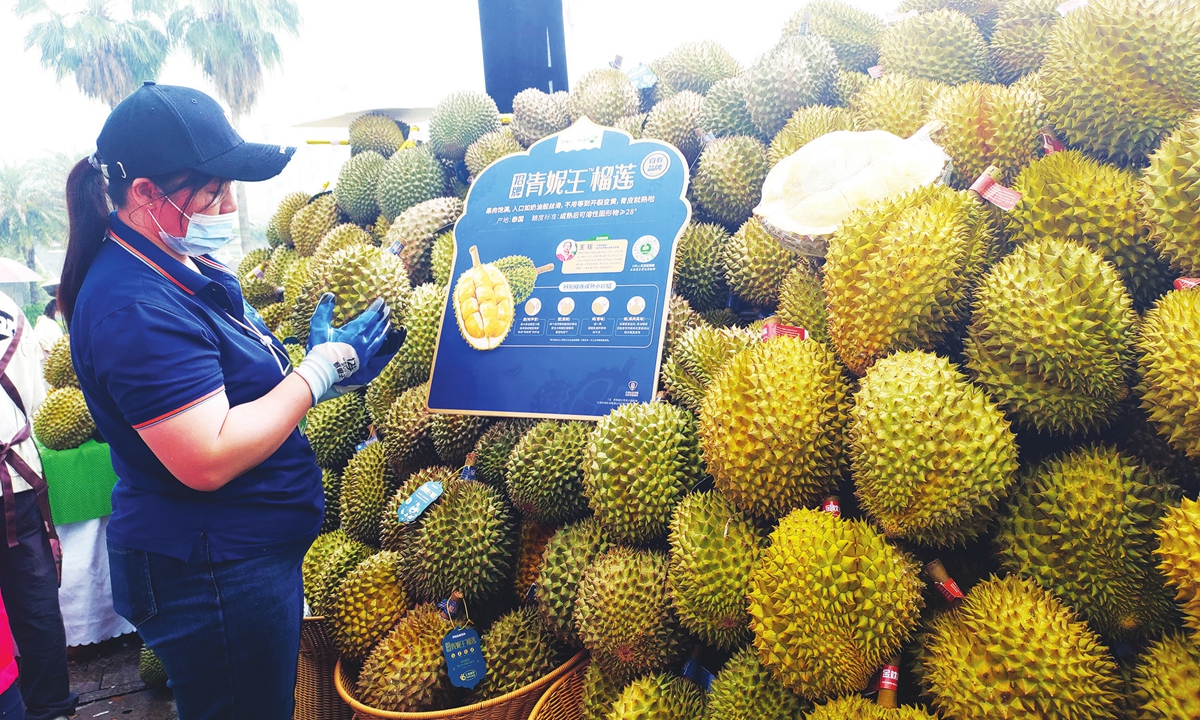Thailand, Vietnam, and the Philippines compete for durian share in China
Nation's trade links with ASEAN members getting closer under RCEP

A salesperson helps consumers select durians during an event to promote Thai durians in Nanning, South China's Guangxi Zhuang Autonomous Region on May 13, 2023. Photo: VCG
It's durian season, and online, some Chinese internet users are sharing the fun experience of opening "durian blind boxes," betting on the size of the durian flesh inside. Those with full and rich flesh are called "repaying durians," while those with shriveled flesh are called "revenge durians," demonstrating the popularity of the fruit among Chinese people.
The enthusiasm of durian lovers in opening blind boxes is also reflected on the e-commerce platforms. From April 1 to mid-May, durian sales on Chinese food delivery platform Meituan surged 711 percent compared to the same period in 2022. Sales in Wuhan, Central China's Hubei Province are up 20 times compared to 2022.
Statistics show that China has imported far more durian fruit this year than in previous years. According to China's General Administration of Customs (GAC), 91,000 tons of fresh durian fruit were imported in the first quarter of 2023, up 154.3 percent from a year ago.
The growth in durian imports has been helped by China's growing trade links with Southeast Asia. Countries include Thailand, Vietnam, and the Philippines have stepped up efforts to expand into the Chinese market.
More durian imported
Hong Yong, an expert from the think tank "digital real economies integration Forum 50," told the Global Times on Monday that the increase in durian imports this year is driven by a rising demand for imported fruit and the implementation of import policies and tariff reduction measures that have promoted the development of the durian import business.
Since the Regional Comprehensive Economic Partnership (RCEP) came into effect, regional economic and trade cooperation has significantly intensified. An increasing number of agricultural products from the Association of Southeast Asian Nations (ASEAN) have gained entry into the Chinese market.
In July 2022, fresh Vietnamese durian was officially allowed to enter the Chinese market. In January 2023, the GAC began to allow the import of fresh durians from the Philippines. Currently, Thailand, Malaysia, Vietnam and the Philippines are the main suppliers of durian to China.
A major importer, Dole Food Co, told the Global Times that the production season of durian from the Philippines is from February to April and from August to October every year, which can make up for the market left open by the Thai durian.
Chen Jia, an independent research fellow on international strategy told the Global Times on Monday that improved infrastructure and connectivity under the Belt and Road Initiative (BRI) and RCEP also make the transportation of the fruit to China much easier for exporters, propelling the business.
A "fruit train" carrying 23 containers of durian and mangosteen arrived in Kunming, Southwest China's Yunnan Province in April, as Thai exporters increasingly turn to the China-Laos Railway for quick access to the Chinese market, the Xinhua News Agency reported.
The transportation of durians is a race against time. Currently, goods can reach Kunming in three days after being transported along the China-Laos Railway from Thailand, where more mature durian fruit is exported.
According to Dole Food Co, China is the third-largest durian consumer after Indonesia and Malaysia, and that China is expected to become the largest durian consumer by 2030.
Durian topped the list of fruits imported by China in 2022, reaching $4.03 billion, with 825,000 tons imported, nearly doubling that from 2014, according to media reports.
Exponential growth expected
The export of durian to the Chinese market is expected to grow exponentially facilitated by the continuous implementation of the BRI and the RCEP, and major export countries are seen to be stepping up efforts to grab the Chinese market.
The commercial office of the Thai consulate in Nanning, South China's Guangxi Zhuang Autonomous Region said that thanks to the effective implementation of the RCEP and efficient and convenient Customs clearance and transportation channels, the exportation of Thai durian to China is expected to see exponential growth in the future, the China News Agency reported.
China was Thailand's largest durian export market in 2022, accounting for 96 percent of total exports, according to Thailand's Ministry of Commerce.
The Philippines aims to export at least 54,000 tons of "premium" fresh durian fruit to China this year, the Department of Agriculture of the Philippines said.
"Stakeholders are now beefing up their production to meet the high demands entailed by the agreement," the department said.
According to the department, the regional agriculture office in Davao, a major durian growing area is also working on a five-year development plan for the durian industry that will intensify technical support, provision of quality planting materials, fertilizer, pesticide, equipment and tools, as well as the establishment of post-harvest facilities.
China has witnessed a year-on-year trade increase of 15 percent with ASEAN in 2022, the first year the RCEP went into effect, and the region continues to hold the position of China's top trade partner.
Chen said that the bilateral economic and trade relations are expected to continue to improve in the future.
"It will not only help accelerate China's macroeconomic recovery and build a high-level opening up pattern, but also help ASEAN members accelerate industrialization and supply chain optimization, and revive their local economies," Chen said.


